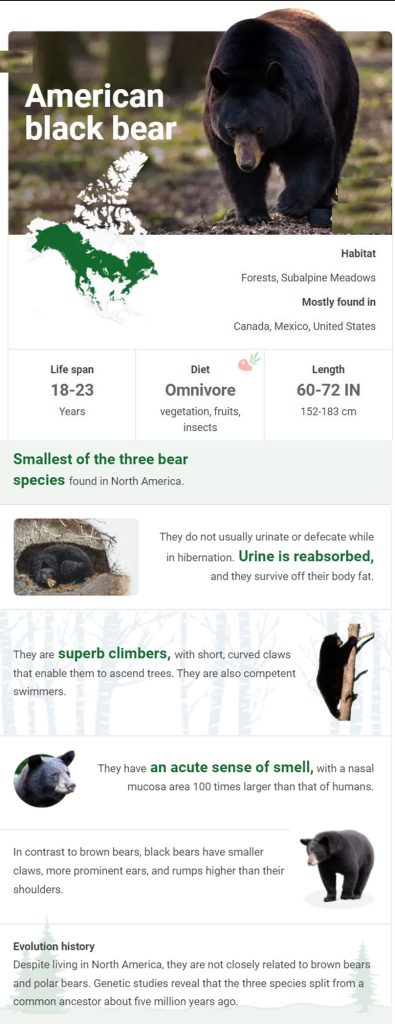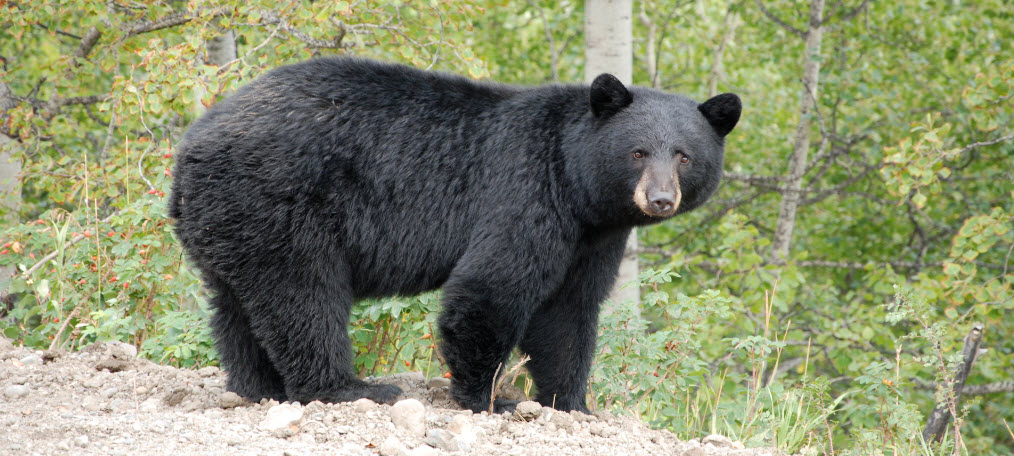
A WORD ABOUT BLACK BEARS
Bears are part of the American landscape. As a native species to North America our history is full of stories about bears. Davy Crockett, “. . . kilt him a bar when he was only three . . .” or so the story goes. Their dominant position in popular culture has caused them to be celebrated in books, movies, television, and the press. An image has developed of bears as roaming, ravaging, killing machines – which only serves to frighten all of us.
SPECIES FACTS
Bears are a species of large, short-tailed carnivores found in the Americas, Europe, and Asia. Adult males weigh between 250 to 350 lbs. The females are smaller, weighing between 130 and 180 lbs.
About 80 percent of a black bear’s diet comes from plants (e.g., fruits, nuts, berries), 15 percent from insects (e.g., termites, ants, yellow jackets) and 5 percent from meat (e.g., opossums, armadillos, carrion). Adult bears live within a 60 square mile area, and females within a 15 square mile area.
Female bears have their first litter at about 3 1⁄2 years old and generally have a litter every other year.
Bears prefer a habitat with a mixture of upland and lowland areas providing the food, water, and shelter they need.
The important thing is our response to any potential presence of a bear. The first rule is DO NOT PANIC. Nor should you use the event to create a panic by overreacting and frightening others. Most visits by bears go unwitnessed. Contrary to tall tales – bears are not maneaters. They do not stalk people, or their pets, in search of a good meal. However, they can be very dangerous if surprised or feel threatened.
Preventing human-bear conflicts begins with following a few simple rules:
- Never feed a bear > They may look cute, but they can be very dangerous. Feeding a bear threatens your safety, the safety of you neighbors, and the safety of the bear itself.
- Secure the top your garbage can > While bears can open large containers, they are lazy and will often seek easier access to food. You can also set your garbage out early in the morning rather than the night before.
- Close the door to your garage > Bears and other creatures may seek food or shelter within. Surprising a bear in the enclosed environment of your garage is an exceedingly dangerous circumstance.
- Helpful tips in the unlikely chance you encounter a bear:
- Bears will let you know if they feel uncomfortable by snapping their jaws, swatting the ground or by “bluff charging.” Always remember to respect bears – they are large, powerful, wild animals that can act unpredictably and become dangerous.
- If you encounter a bear at a distance, do not approach. Enjoy the experience from a safe distance and back away slowly. Surprising a bear, blocking escape routes, and making eye contact could make the bear feel threatened and should be avoided. If you are on your deck or screened porch – the screen will not protect you. Follow the steps previously stated.
- If you encounter a bear at close range:
a. Stay calm
b. Do not make eye contact
c. Make yourself look big by raising your arms
d. Back away slowly
Black bears can sprint up to 35 mph and are great climbers. Never run or climb a tree to escape a black bear; it may trigger their chase instinct and possibly an attack. If a bear stands up, try not to react. Bears are curious and will stand up to get a better look at you and their surroundings. - Scare That Bear!
If you see a bear in your yard, consider “scaring that bear!” The goal is to preserve their natural fear of people.
Reinforce their timid nature by scaring bears that wander onto your property or near your home. Some things to remember before attempting to scare the bear:
• Ensure the bear has an easy escape route away from you and your home
• Check that you are in a secure area at a safe distance from the bear
• Use noise or water to scare the bear away, or hitting pots and pans together, turning on sprinklers, or honking car horns are all acceptable ways to scare off a bear.
But remember, bears are a protected species!

